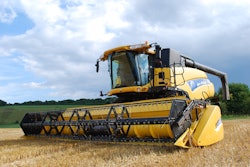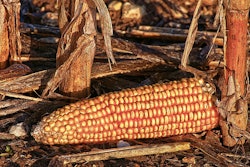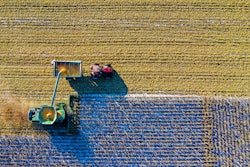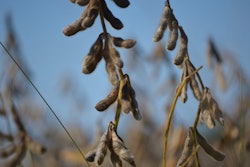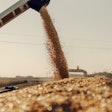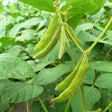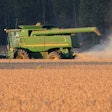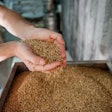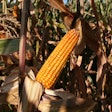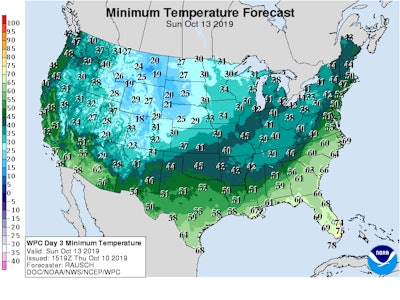
According to U.S. Department of Agriculture’s National Agricultural Statistics Service, 84% of corn in North Dakota had reached full dent on Oct. 6, which likely will result in corn with a test weight of 50 to 53 pounds per bushel and a moisture content of 35% to 45%, according to Ken Hellevang, North Dakota State University agricultural engineer and grain drying expert.
Only about 22% of the corn had reached maturity on that date, and that corn probably will have a test weight of about 56 pounds per bushel and a moisture content of about 30%.
“It is important to check each field because these values will vary depending on planting date, corn maturity rating and growing degree days during the year,” Hellevang says. “For the 18 states producing the majority of the corn in the U.S., only 58 percent of the corn was mature on Oct. 6.
The amount of drying in the field depends on parameters such as corn maturity, hybrid, moisture content, air temperature, relative humidity, solar radiation and wind speed.
Corn growing degree days have been used to predict the rate of field drying, but they do not consider all the drying parameters. Another predictor of the drying rate is potential evapotranspiration (PET), which is based on parameters similar to those that affect drying. Values for PET are available on the North Dakota Agricultural Weather Network website at http://ndawn.ndsu.nodak.edu. About 1 inch of potential evapotranspiration results in about 4 percentage points of corn field drying.
Standing corn in the field may dry about 2.5 percentage points per week in North Dakota during October, assuming normal weather conditions, and about 1 percentage point per week during November. Corn at 35% moisture content on Oct. 11 might be expected to dry to about 27% by Nov. 1 and about 22% by Dec. 1, Hellevang says. Therefore, corn moisture content at harvest likely will be in the mid-20% range this year.
The current forecast is for the minimum temperature to be in the 20s in the western portion of the Dakotas and Nebraska on Oct. 11 and below freezing for the Dakotas and Nebraska on Oct. 12, but Minnesota and Iowa are forecast to stay just above freezing. The Oct. 14-18 temperature is predicted to be much below normal across the Corn Belt, with a tendency for above-normal precipitation for Oct. 16-22.
“If these forecasts are accurate, the amount of field drying will be reduced,” Hellevang cautions.
Iowa State University has a field dry-down model that may be helpful. Do an internet search for Iowa Corn dry down calculator. It estimates that if corn is at 35% moisture on Oct.11, it will, on average, dry to about 22% on Oct. 30.
Field drying normally is more economical until mid to late October in North Dakota and mechanical high-temperature drying normally is more economical after that, Hellevang notes.
Field drying is extremely slow during winter months and corn will dry only to about 20% moisture content based on the equilibrium moisture content for average monthly air temperature and relative humidity conditions in North Dakota. Corn that remains in the field during the winter may dry from 25% to 30% moisture in November to 17% to 20% when harvested in February and early March.
Corn losses will depend on stalk strength, ear shank attachment to the stalk, winter conditions and wildlife. Accumulated winter snow adds water to the soil as it melts. Plus, standing corn shades the ground, which reduces drying and may lead to wet fields in the spring, so consider harvesting the corn before the ground thaws.
Natural-air and low-temperature drying are limited to initial corn moisture contents of about 21%. Even at that moisture content, air drying is limited in the northern states due to the colder outdoor temperatures in late October and November.
The moisture-holding capacity of air is very small at temperatures below about 40 F. Expect to store the wet corn for the winter by cooling it to 20 to 30 F and finishing the drying in the spring when outside temperatures average above 40 F.
Provide an airflow rate of at least 1 cubic foot per minute per bushel (cfm/bu) to complete the drying before corn deterioration affects the market quality. The required fan size to provide the needed airflow can be determined using a fan selection program. Do an internet search for NDSU grain drying and storage to access a fan program.
玉米产量的midportion州将have a more rapid field dry down due to the warmer temperatures. Natural-air drying also is more feasible there due to the warmer November temperatures.
For example, corn reaching maturity in Nebraska on Oct. 11 is expected to dry in the field to about 21% on Oct. 30. The average November temperature in Nebraska is about 40 F, so air drying likely is feasible in November. However, with an airflow rate of 1 cfm/bu, drying may not be completed in November.
High-temperature corn drying may face challenges with high-moisture corn. The kernel color of immature corn may be affected during drying due to sugars still being in the kernel. Reduce the dryer temperature to reduce the potential for affecting the kernel.
Hellevang also warns that corn at moisture contents above about 23% may have enough surface moisture on the kernels that the kernels freeze together and will not flow.
For more information on high-moisture corn drying and storage,click here.
NDSU Agriculture Communication
Source: Ken Hellevang, 701-231-7243,[email protected]
Editor: Ellen Crawford, 701-231-5391,[email protected]





